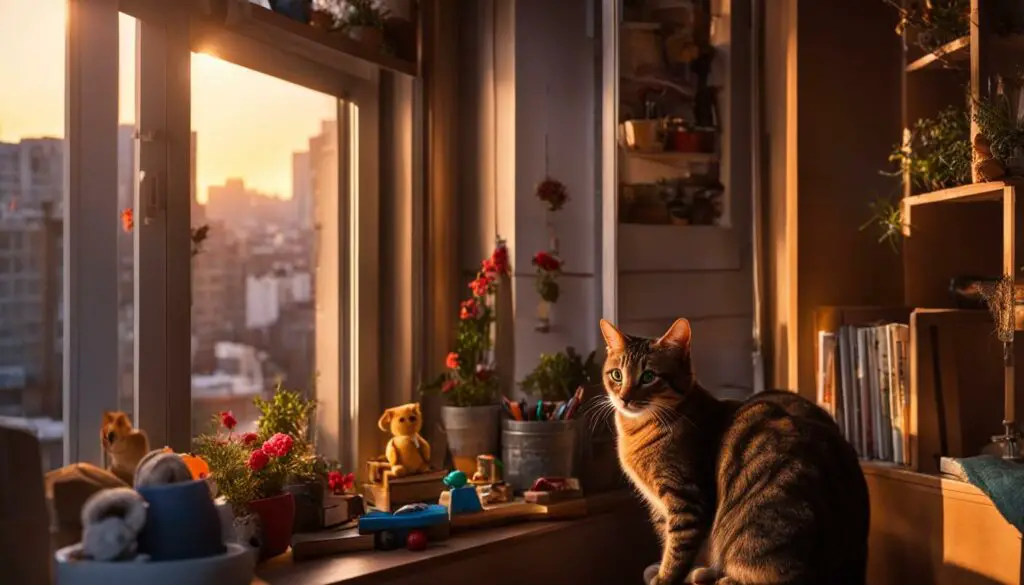As a cat lover and owner of a studio apartment, I understand the concerns surrounding the well-being of our furry friends in small living spaces. However, the size of the apartment doesn’t necessarily determine the happiness of a cat. It’s all about how we create an enriching environment that meets their needs.
Cats can be perfectly content in a studio apartment if we provide them with the right amenities and stimulation. By maximizing both vertical and cubic space, we can create a fascinating playground for our feline companions. Cat trees, toys, and accessories can transform a small space into a world of adventure. Mimicking outdoor stimuli and providing access to natural light can further enhance their well-being.
Some may worry about the litter box situation, but with a quiet spot and proper cleaning, it can easily be managed. Cats are also adept at finding their own hideaways in small corners and cozy spots, making a studio apartment feel safe and comforting for them.
So, let’s dive deeper into the world of cat care in small spaces and discover how we can provide a fulfilling and happy life for our furry friends in a studio apartment.
Key Takeaways:
- Creating an enriching environment is key to keeping a cat happy in a studio apartment.
- Maximize vertical and cubic space with cat trees, toys, and accessories.
- Mimic outdoor stimuli and provide access to natural light.
- Ensure a quiet spot for the litter box and maintain cleanliness.
- Cats are adaptable and can find comfort in small spaces.
Tips for Creating a Cat-Friendly Studio Apartment
Creating a cat-friendly environment in a studio apartment is essential to ensure your feline companion’s happiness and well-being. Here are some tips to help you transform your small living space into a paradise for your cat:
- Provide access to sunlight and outdoor views: Mount a cat hammock in a window or place a cat tree near a sliding glass door. This allows your cat to bask in the sunlight and observe the world outside.
- Satisfy their scratching needs: Cats have a natural instinct to scratch, so it’s important to provide them with appropriate scratching posts. Choose sturdy, durable options that are tall enough for them to stretch their bodies.
- Utilize vertical space: Install shelves on the walls to create more climbing and exploring opportunities for your cat. Vertical space not only saves floor space but also satisfies their natural desire for height.
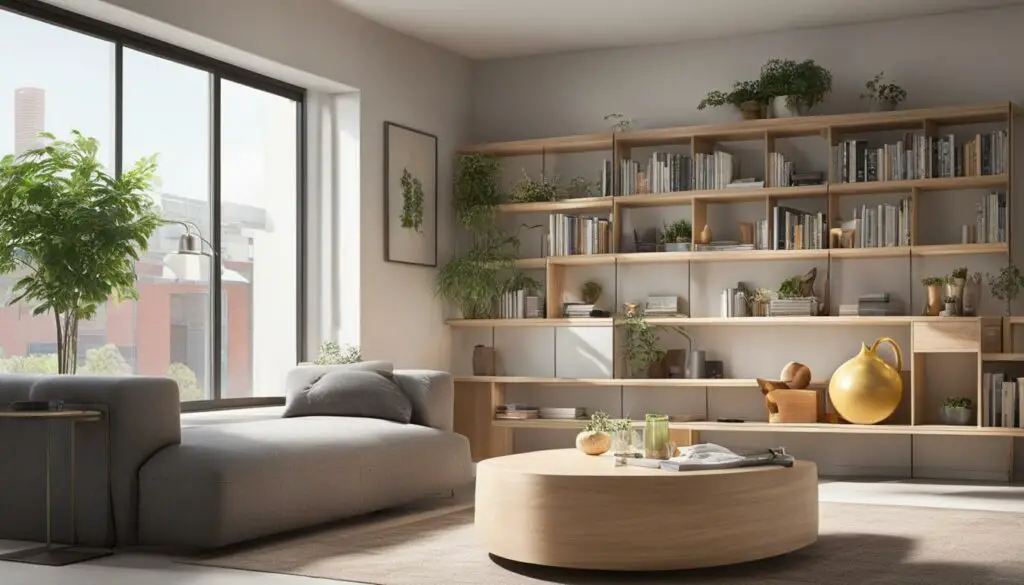
4. Engage their prey instincts: Choose interactive toys that stimulate your cat’s hunting instincts. Toys with feathers or strings attached can provide hours of entertainment and exercise.
5. Create a private space: Cats also need their alone time. Place cardboard boxes in different corners of your apartment to serve as hiding spots and retreats for your cat when they desire some privacy.
| Tip | Description |
|---|---|
| Access to sunlight | Mount a cat hammock in a window or place a cat tree near a sliding glass door. |
| Satisfy scratching needs | Provide appropriate scratching posts to fulfill their natural instinct. |
| Utilize vertical space | Install shelves on the walls to create climbing opportunities and save floor space. |
| Engage prey instincts | Choose interactive toys that stimulate hunting instincts. |
| Create a private space | Place cardboard boxes as hiding spots and retreats. |
How Much Space do Cats Need in a Studio Apartment?
When it comes to the amount of space cats need in a studio apartment, the answer may surprise you. While larger living spaces may seem like the ideal environment for a cat, the truth is that cats can adapt and thrive in smaller spaces as well. In fact, many cats actually prefer smaller, safer areas where they can feel secure and in control.
A general recommendation is to provide cats with at least 18 square feet of space in a studio apartment. However, it’s important to note that this is just a guideline and each cat is unique in their individual needs and preferences. Some cats may be perfectly content with a smaller area, while others may require more room to roam and explore.
To create a cat-friendly environment in a limited space, it’s all about making the most of the available vertical space. This can be done by installing cat shelves on the walls, providing perches, and creating hiding spots. Additionally, ensuring that your cat has access to essential items like litter boxes, scratching posts, and hiding places will help meet their needs and create a comfortable living space for them.
By utilizing vertical space and providing necessary cat furniture, you can create an environment that meets your cat’s needs in a studio apartment. Remember to observe your cat’s behavior and make adjustments accordingly to ensure they are happy and content in their limited living space.
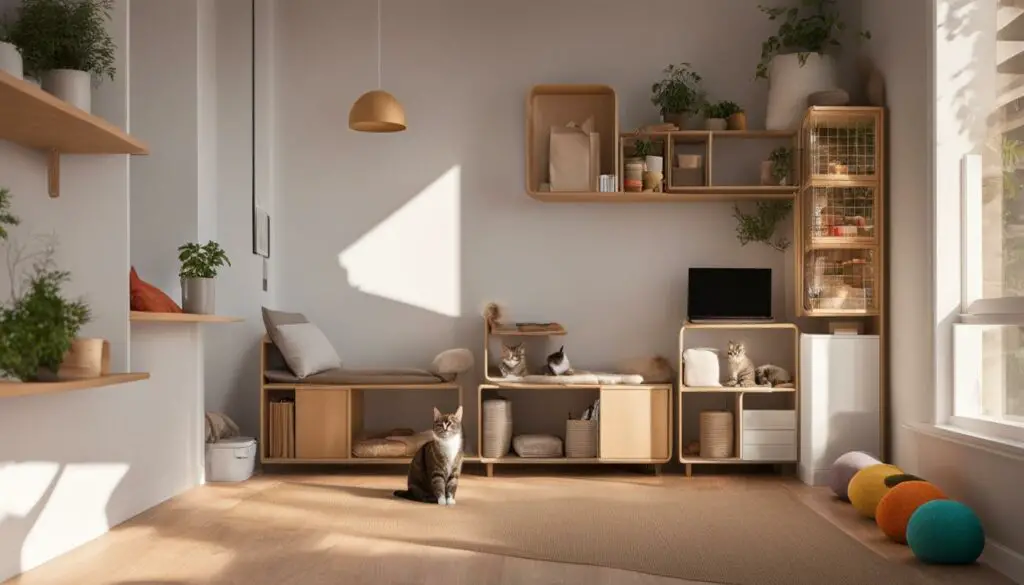
Reasons for Keeping a Cat in a Studio Apartment
Living with a cat in a studio apartment can bring immense joy and companionship. While some may question the suitability of keeping a cat in limited space, there are several reasons why it can be a great choice.
Cats naturally seek out hideaways and corners, making the confined space of a studio apartment perfect for their comfort. They often find solace in small, secure areas where they can relax and observe their surroundings. Keeping a cat in one room can also be advantageous for various situations. It provides a separate space for introducing a new pet or containing a cat’s access to certain areas of the home. Additionally, if you have an ill cat, confining them to a studio apartment can provide a quiet and cozy environment for rest and recuperation.
Living with a cat in a studio apartment can also be beneficial for those who experience social anxiety. Cats can provide emotional support and companionship, helping individuals feel more at ease in their living space. With proper care and attention, a studio apartment can offer all the essentials a cat needs, including food, water, litter boxes, and adequate space for play and rest.
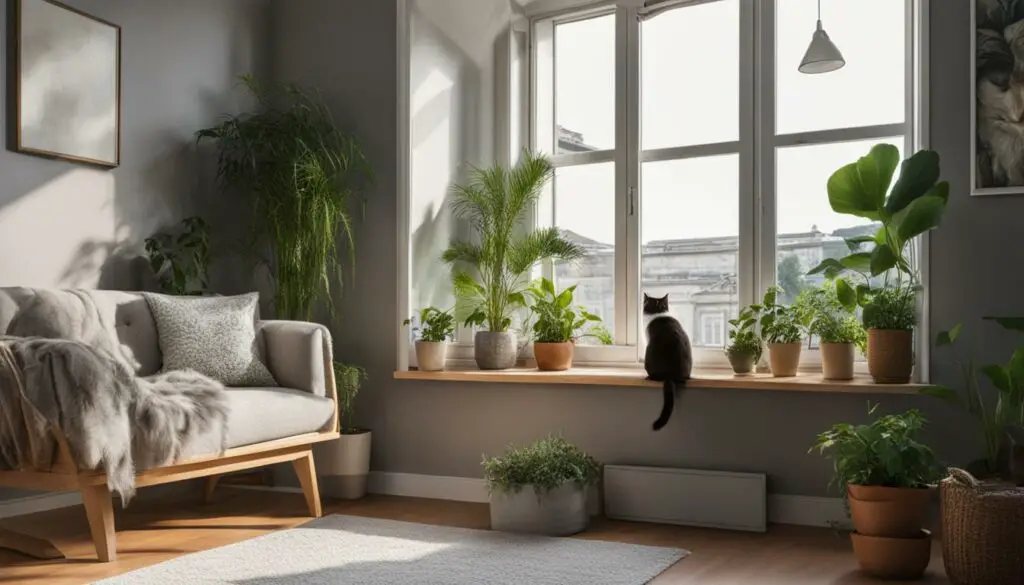
Creating a Cat-Friendly Studio Apartment
To ensure your cat’s happiness in limited space, it’s important to create a cat-friendly studio apartment. Consider providing vertical and cubic space by incorporating cat trees, shelves, and climbing poles. These features not only maximize the available space but also offer opportunities for exercise and exploration. Interactive toys that simulate prey instincts can also keep your cat entertained and mentally stimulated.
| Benefits of Keeping a Cat in a Studio Apartment | Considerations for Cat-Friendly Living |
|---|---|
| 1. Companionship and emotional support | 1. Provide a quiet spot for litter box |
| 2. Reduced stress and anxiety | 2. Ensure easy access to food and water |
| 3. Sense of home and belonging | 3. Offer vertical space for climbing and exploring |
| 4. Entertainment and unconditional love | 4. Regularly clean the litter box for hygiene |
Living with a cat in a studio apartment can bring immense joy and companionship.
By addressing your cat’s needs for privacy, scratching, play, rest, and access to essential resources, you can create a cat-friendly space in your studio apartment. Keep in mind that while cats can adapt to living in small spaces, it’s important to provide them with enough mental and physical stimulation. Regular playtime, social interaction, and a consistent routine can help ensure a harmonious living arrangement for both you and your feline companion.
How to Create a Cat-Friendly Space in a Studio Apartment
Creating a cat-friendly space in a studio apartment is crucial for the well-being and happiness of your feline companion. By considering their needs and making a few adjustments, you can ensure that your cat feels comfortable and content in their limited living space.
Utilize Vertical Space: Cats love to climb and explore, so providing opportunities for vertical movement is essential. Install cat shelves or climbing poles on the walls to create elevated pathways for your cat to navigate. This not only maximizes the use of space but also allows your cat to engage in natural behaviors.
Invest in Multi-Functional Furniture: Opt for cat furniture that serves a dual purpose, such as a cat bed that doubles as a storage ottoman or a cat tree that includes scratching posts and hiding spots. This allows you to save space while providing essential resources for your cat’s well-being.
Choose Inconspicuous Litter Boxes: Litter boxes can take up valuable space in a small apartment, so it’s important to choose ones that blend seamlessly with your decor. Consider concealed litter box cabinets or ones that can be placed under furniture to maintain a visually pleasing environment.
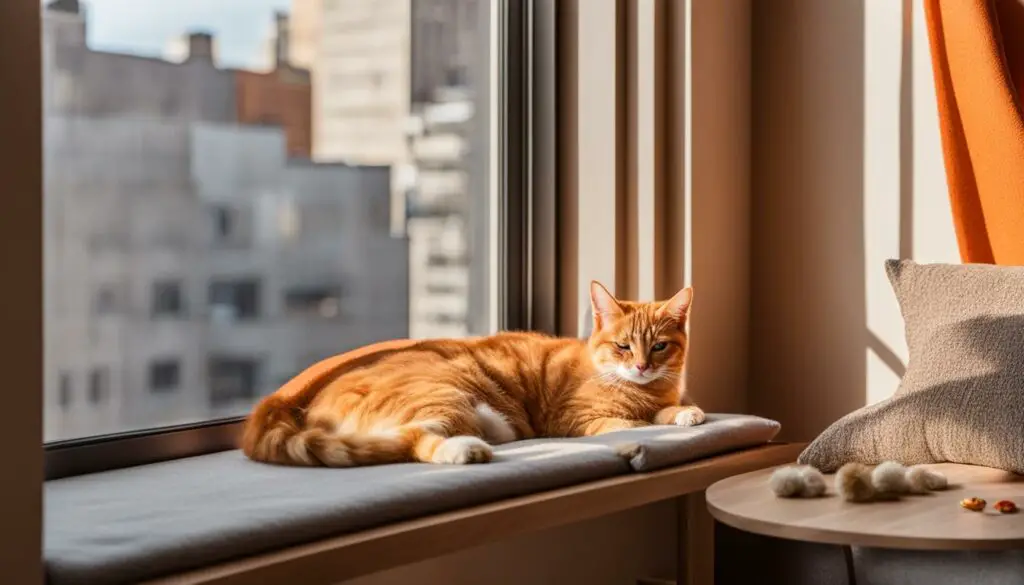
Creating a cat-friendly space in a studio apartment can be a rewarding experience. By considering vertical space, investing in multi-functional furniture, and choosing inconspicuous litter boxes, you can create an environment that meets your cat’s needs while maintaining a visually appealing living space.
Cat Room Ideas for Small Homes
Living in a small home with a cat doesn’t mean sacrificing their comfort and happiness. With some creativity and strategic furniture selection, you can create a cat-friendly space that meets their needs. Here are some ideas to transform your small home into a feline paradise:
Create Vertical Space
Incorporate cat shelves, towers, or climbing poles to maximize vertical space. Cats love to climb and perch up high, so these additions provide them with opportunities for exploration and a sense of territory.
Choose Dual-Purpose Furniture
Look for modern cat furniture that serves a dual purpose, such as litter box cabinets or hammock glass coffee tables. These functional pieces save space and blend seamlessly with your home decor while providing essential amenities for your cat.
Provide Playful Elements
Add interactive toys and foldable cat tunnels to engage your cat in playtime. These accessories stimulate their natural instincts and provide mental and physical stimulation. With foldable options, you can easily store them when not in use.
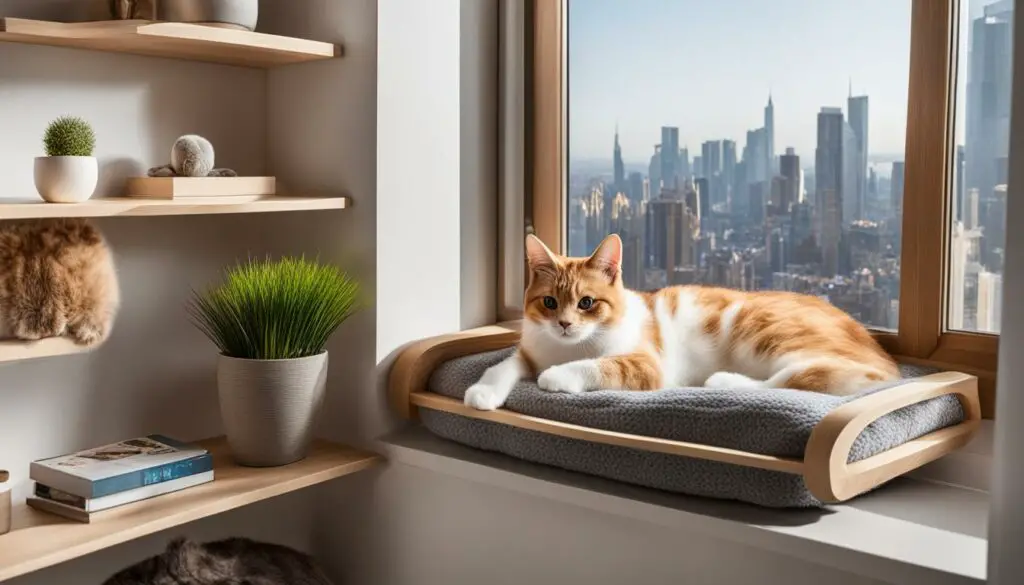
| Cat Room Ideas for Small Homes | Benefits |
|---|---|
| Vertical Space | Maximizes limited space, fulfills cats’ climbing instincts |
| Dual-Purpose Furniture | Saves space, blends with home decor seamlessly |
| Playful Elements | Provides mental and physical stimulation for cats |
Key Considerations for Keeping a Cat in a Studio Apartment
When it comes to keeping a cat in a studio apartment, there are a few key considerations to keep in mind to ensure the well-being of your feline friend. While cats can adapt well to smaller living spaces, it’s important to create an environment that meets their needs.
Provide a quiet spot for their litter box: Cats appreciate privacy when it comes to their bathroom habits. Find a secluded corner or area where you can place the litter box. This not only helps maintain cleanliness but also ensures your cat feels comfortable using it.
Offer enough vertical space: Cats love to climb and explore their surroundings. Provide tall scratching posts, cat trees, or shelves where your cat can perch and survey their territory. Vertical spaces not only offer exercise but also give cats a sense of security in a limited space.
| Key Considerations for Keeping a Cat in a Studio Apartment |
|---|
| Provide a quiet spot for their litter box |
| Offer enough vertical space |
| Consider your cat’s individual preferences |
| Regular play and social interaction are essential |
Consider your cat’s individual preferences: Every cat has unique preferences and behaviors. Some cats may prefer a cozy hiding spot, while others may enjoy interactive toys or windowsills for bird-watching. Observe your cat’s likes and dislikes to tailor the environment to their specific needs.
Regular play and social interaction are essential: Living in a small space means your cat may need extra stimulation and exercise. Set aside time each day for play sessions to keep them mentally and physically engaged. Social interaction is also crucial for their overall well-being, so be sure to spend quality time with your cat.
Addressing Concerns About Cruelty in a Studio Apartment
Many people wonder whether it is cruel to keep a cat in a small apartment. However, with proper care and attention, it is not cruel at all. Cats are highly adaptable animals and can thrive in limited spaces as long as their needs are met. By providing a stimulating and enriching environment, we can ensure their well-being.
Cat welfare in a small apartment is achievable by maximizing vertical and cubic space. Investing in cat trees, shelves, and wall-mounted climbing posts can give cats opportunities for exercise, exploration, and mental stimulation. These structures not only provide physical outlets for their energy but also mimic their natural instincts to climb and perch.

Additionally, it is important to address their behavioral and physiological needs. Ensuring access to natural light and fresh air, providing hiding spots and cozy resting areas, and engaging them in interactive play help maintain their mental and emotional well-being. Regular social interaction and playtime are essential for cats to feel happy and fulfilled in a small space.
With the right care and attention, a studio apartment can provide a safe and fulfilling home for your feline companion.
Benefits of Prioritizing Cat’s Well-being in a Studio Apartment
By addressing concerns about cruelty in a studio apartment, we not only provide a comfortable space for our cats but also experience numerous benefits. Cats offer companionship, reduce stress levels, and bring joy to our lives. They can create a sense of home in a small living space and provide emotional support and unconditional love.
So, rather than focusing on whether it is cruel to keep a cat in a small apartment, let’s instead prioritize their well-being and ensure they have everything they need to live a happy and fulfilling life.
| Benefits of Having a Cat in a Studio Apartment |
|---|
| Companionship and emotional support |
| Stress reduction and improved mental well-being |
| Creating a sense of home and belonging |
| Unconditional love and entertainment |
Benefits of Having a Cat in a Studio Apartment
Living with a cat in a small apartment can bring numerous benefits and enhance your overall living experience. Despite the limited space, the companionship and love that cats provide can create a warm and welcoming atmosphere in your studio apartment.
Cat companionship in limited space can greatly reduce stress and loneliness. Cats are known for their calming presence and can help create a sense of home even in the smallest living quarters. Whether you’re studying, working, or simply relaxing, having a cat by your side can provide emotional support and a constant source of entertainment.
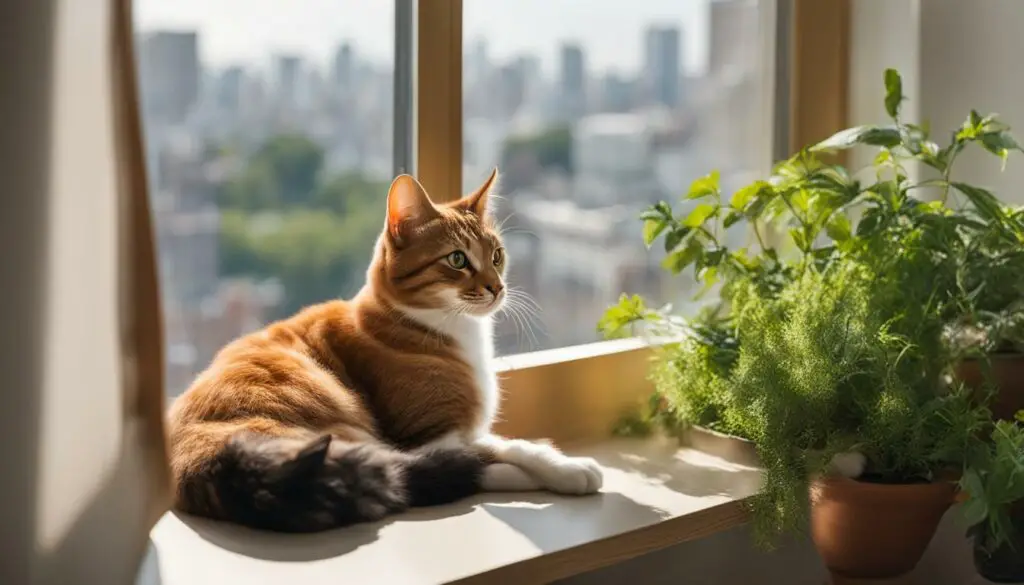
Cats are masters of finding joy in the simplest things, and their curiosity and playfulness can add a new dimension to your everyday life. From observing their agile movements to engaging in interactive play sessions, you’ll never be short of entertainment with a cat in your studio apartment.
Additionally, cats are known for their unconditional love and affection. Their presence can bring a sense of comfort and happiness, creating a loving bond that can be incredibly rewarding. Whether you’re relaxing on the couch or curled up in bed, having a furry friend to snuggle with can bring immense joy and comfort.
Tips for Living with a Cat in a Small Apartment
Living with a cat in a small apartment can be a rewarding experience with a few practical tips to ensure a harmonious and comfortable environment for both you and your feline friend. Here are some tips to help you navigate cat care in limited space:
1. Establish a Consistent Routine
Creating a consistent routine is essential for cats in small apartments. Set regular feeding times, play sessions, and litter box maintenance to provide structure and predictability. Cats thrive on routine and will feel more secure and content in their environment.
2. Maximize Vertical Spaces
In a small apartment, vertical spaces are a great way to provide additional room for your cat to climb and explore. Install cat shelves, wall-mounted perches, or a multi-level cat tree to optimize space and give your cat opportunities for exercise and mental stimulation.
3. Engage in Interactive Play
Regular interactive play sessions are crucial for cats living in limited space. Use interactive toys, feather wands, or laser pointers to engage your cat in playtime. This not only provides physical exercise but also simulates their natural hunting instincts.
4. Keep your Apartment Clean and Organized
Regular cleaning and organization are important in a small apartment with a cat. Maintain a clean litter box to prevent odors, vacuum regularly to remove cat hair, and keep surfaces free of clutter. A tidy living space will contribute to a more peaceful and enjoyable environment for both you and your cat.
By implementing these tips, you can create a cat-friendly living space in your small apartment and ensure a happy and fulfilling life for your feline companion.
| Tips for Living with a Cat in a Small Apartment |
|---|
| Establish a Consistent Routine |
| Maximize Vertical Spaces |
| Engage in Interactive Play |
| Keep your Apartment Clean and Organized |
Understanding a Cat’s Behavior in a Studio Apartment
Living with a cat in a studio apartment requires understanding their behavior and providing suitable accommodations. Cats can adapt well to small spaces, but it’s essential to create an environment that meets their natural instincts and needs. By observing their behavior and making necessary adjustments, you can ensure a harmonious living arrangement for both you and your feline friend.
One common behavior in cats living in small apartments is scratching. Cats scratch to mark their territory, stretch their muscles, and keep their claws healthy. To prevent damage to furniture, provide plenty of vertical scratching surfaces such as cat trees, scratching posts, or wall-mounted scratching boards. These options not only satisfy their scratching needs but also utilize vertical space, maximizing the available area in your studio apartment.
Hiding and seeking hiding spots is another typical behavior in cats. In a small space, it’s essential to provide them with cozy nooks where they can retreat and feel safe. Consider adding hideaways such as cat caves, cozy beds, or even cardboard boxes with soft bedding. These hiding spots give cats a sense of security and privacy, helping them feel comfortable and at ease in their limited space.
| Behavior | Accommodation |
|---|---|
| Scratching | Vertical scratching surfaces such as cat trees, scratching posts, or wall-mounted scratching boards. |
| Hiding | Cozy nooks, cat caves, cozy beds, or cardboard boxes with soft bedding. |
| Vertical Exploration | Shelving, cat trees, or wall-mounted perches. |
| Play and Exercise | Interactive toys, puzzle feeders, and playtime with their human companion. |
Vertical exploration is also an important aspect of a cat’s behavior. Cats naturally love to climb and observe their surroundings from a higher vantage point. Install shelves or invest in a cat tree that provides various levels for climbing and perching. This not only satisfies their instinctual behavior but also creates additional vertical space, making your studio apartment feel more spacious for both you and your cat.
Cats require mental and physical stimulation, regardless of the living space. Play with your cat regularly using interactive toys that engage their hunting instincts. Puzzle feeders can also provide mental stimulation while satisfying their hunger. Establish a daily routine that includes playtime to prevent boredom and encourage exercise. A stimulated cat is a happy cat, even in a small studio apartment.
Choosing the Right Cat for a Studio Apartment
When it comes to choosing a cat for a studio apartment, there are a few factors to consider to ensure a harmonious living environment. It’s important to select a cat breed that is well-suited for limited spaces and can thrive in an indoor setting. Here are some cat breeds that are known to adapt well to small apartments:
- Ragdoll: This breed is known for its docile and easygoing nature, making it well-suited for apartment living.
- British Shorthair: With their calm and independent temperament, British Shorthairs are content with their own company and don’t require excessive exercise.
- Persian: These cats are known for their love of tranquility and are perfectly content lounging in a small apartment.
- Russian Blue: Intelligent and low-maintenance, Russian Blues are adaptable to various living conditions and are great companions for apartment dwellers.
- Sphynx: Despite their unique appearance, Sphynx cats are friendly, affectionate, and can adapt well to apartment living.
It’s important to note that individual cat personalities can vary, so it’s essential to spend time with the cat before making a final decision. Additionally, consider adopting a mixed-breed cat from a shelter, as they can also make wonderful companions and adapt well to apartment living.
Remember that regardless of the breed, all cats need mental stimulation and exercise. Providing vertical spaces, interactive toys, and regular playtime can help keep your cat happy and content in a studio apartment.
| Cat Breed | Temperament | Adaptability to Small Spaces |
|---|---|---|
| Ragdoll | Docile, easygoing | Well-suited for apartment living |
| British Shorthair | Calm, independent | Content with their own company |
| Persian | Tranquil, relaxed | Happy in a small apartment |
| Russian Blue | Intelligent, low-maintenance | Adaptable to various living conditions |
| Sphynx | Friendly, affectionate | Can adapt well to apartment living |
“Choosing the right cat breed for a studio apartment is crucial for both the cat’s well-being and your living situation. Cats that are known for being adaptable, low-energy, and independent make excellent companions in small spaces. Whether you choose a purebred or mixed-breed cat, providing a loving and stimulating environment will ensure a happy and content feline friend.”
Addressing Potential Challenges of Keeping a Cat in a Studio Apartment
Living with a cat in a small apartment can present some unique challenges. However, with proper planning and care, you can overcome these challenges and provide a comfortable and happy space for both you and your furry friend.
One challenge of living in a studio apartment with a cat is the limited space. Cats are naturally curious and active animals that require room to explore and play. To address this challenge, consider maximizing the vertical space in your apartment by installing cat shelves or providing climbing poles. These additions can create additional areas for your cat to climb and explore, helping to make the most of your limited space.
Another challenge is managing odors and cleanliness in a small living space. With limited room for a litter box, it’s important to establish a regular cleaning routine to prevent offensive odors. Consider using odor-controlling litter and ensuring proper ventilation in your apartment. Additionally, regular grooming and brushing can help minimize shedding and keep your apartment clean.
Lastly, social interaction and playtime are essential for a cat’s well-being, and it can be more challenging to provide these activities in a small apartment. However, there are ways to overcome this challenge. Dedicate specific play areas in your apartment where you can engage in interactive play with your cat. Use stimulating toys and provide scratching posts to keep them active and entertained. Additionally, consider setting up a window perch to provide your cat with a view of the outside world, which can help reduce boredom.
| Challenges of Keeping a Cat in a Studio Apartment |
|---|
| Limited space for exploration and play |
| Managing odors and cleanliness |
| Providing social interaction and playtime |
By addressing these potential challenges, you can ensure a harmonious living environment for both you and your feline companion. Remember to prioritize your cat’s physical and mental well-being, provide them with ample stimulation and enrichment, and create designated areas for play, rest, and privacy. With proper care and attention, you can create a loving and fulfilling home for your cat in a small apartment.
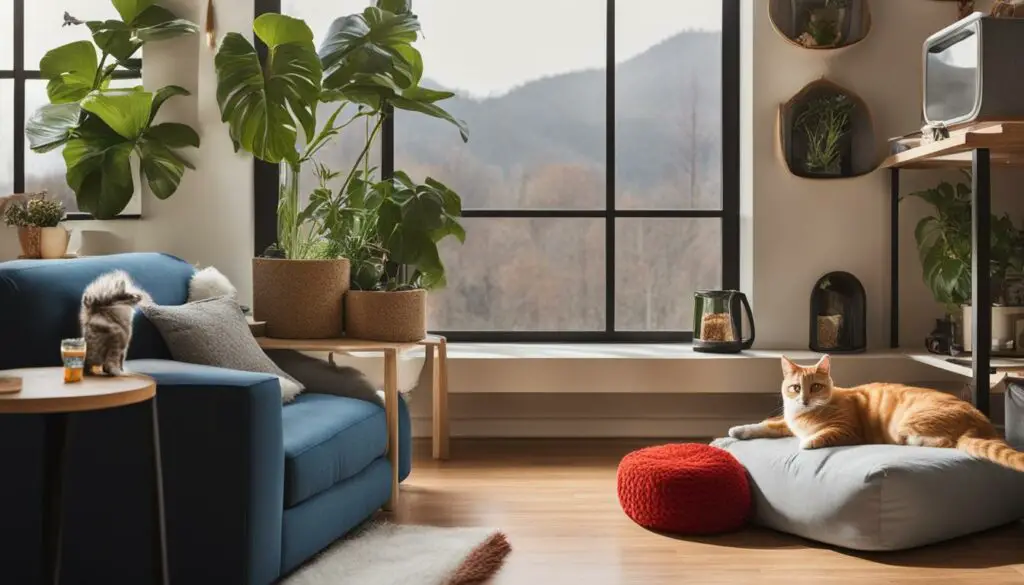
Tips for Balancing Personal Space and Cat Ownership in a Studio Apartment
Living in a studio apartment with a cat can be a wonderful experience, but it’s important to find a balance between your personal space and your feline companion’s needs. Here are some tips to help you maintain privacy and create a harmonious living environment:
1. Create designated areas
Designate specific areas in your studio apartment for yourself and your cat. Use furniture placement and arrangements to separate living spaces. This can be as simple as positioning a bookshelf or screen to create a visual barrier. Having defined areas will help both you and your cat feel like you have your own personal spaces.
2. Provide hiding spots
Cats naturally seek out hiding spots when they want privacy or a quiet retreat. Create hiding spots for your cat in different areas of your apartment using items like cat tunnels, cardboard boxes, or cozy cat beds placed in secluded corners. These spots can give your cat a sense of security and provide them with the privacy they need.
3. Establish boundaries
Establish clear boundaries with your cat to maintain your personal space. Train your cat to stay off certain furniture or areas that you want to keep cat-free. Use positive reinforcement techniques, such as treats or praise, to encourage good behavior and redirect your cat to their designated spaces. Consistency is key in reinforcing these boundaries.
Remember, open communication with your cat is essential. Cats are intelligent animals and can understand your cues and boundaries when communicated effectively. By creating designated areas, providing hiding spots, and establishing boundaries, you can strike a balance between personal space and cat ownership in your studio apartment.
| Benefits | Challenges |
|---|---|
| Companionship | Limited space |
| Stress reduction | Odor control |
| Sense of home | Increased social interaction |
| Emotional support | Indoor exploration |
“Creating designated areas and establishing boundaries can help create a harmonious living environment for both you and your cat. It’s all about finding a balance that allows for personal space while still providing your cat with the love and care they need.” – Cat Owner

Conclusion
After exploring the topic of keeping a cat in a studio apartment, it is clear that it is not cruel to do so. Cats are highly adaptable and can thrive in small spaces as long as their needs are met. By creating a cat-friendly environment with vertical and cubic space, providing enrichment and stimulation, and considering their individual preferences, we can ensure their well-being and happiness.
It is essential to understand that cats can find comfort in smaller, safer areas and may even prefer them. With careful planning and the right setup, a studio apartment can provide a fulfilling and safe home for your feline companion.
Remember to prioritize their basic needs, such as a quiet spot for their litter box, access to natural light, and opportunities for play and exploration. Regular interaction, proper care, and attention are essential for their overall well-being. By considering these factors and providing a loving and enriched environment, you can create a harmonious living arrangement with your cat in a studio apartment.
FAQ
Is it cruel to keep a cat in a studio apartment?
No, cats can be perfectly happy in small spaces as long as their needs are met.
How much space do cats need in a studio apartment?
Cats can adapt to living in small spaces, but a general recommendation is 18 square feet of space.
What are the reasons for keeping a cat in a studio apartment?
Some reasons include space limitations, managing social anxiety, or introducing a new pet.
How can I create a cat-friendly space in a studio apartment?
You can utilize vertical space, provide cat furniture and toys, and mimic outdoor stimuli.
What are some cat room ideas for small homes?
Ideas include mounting a cat hammock in a window, installing shelving on the walls, and using cardboard boxes as hiding spots.
What are some key considerations for keeping a cat in a studio apartment?
Consider the cat’s need for privacy, scratching, play, rest, and access to food and water.
Is it cruel to keep a cat in a studio apartment?
No, as long as their needs are met with proper care and attention.
What are the benefits of having a cat in a studio apartment?
Cats provide companionship, reduce stress, and create a sense of home in a small living space.
What are some practical tips for cat owners in studio apartments?
Establish a routine, keep the apartment clean, and engage in interactive play with the cat.
How can I understand a cat’s behavior in a studio apartment?
Cats may exhibit natural behaviors such as scratching, climbing, and hiding. Provide appropriate outlets for these behaviors.
How do I choose the right cat for a studio apartment?
Consider the cat’s activity level, temperament, and individual needs.
What are some potential challenges of keeping a cat in a studio apartment?
Limited space may require more diligent cleaning, and cats may require more social interaction or playtime.
How can I balance personal space and cat ownership in a studio apartment?
Create designated areas for the cat and yourself, establish boundaries, and communicate effectively.
Can a cat be happy in a studio apartment?
Yes, cats can be happy in a studio apartment if their needs are met with proper care and attention.

